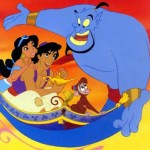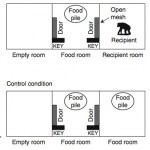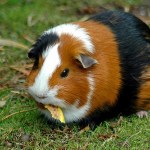mammals
Bonobo Week continues! I'm donating whatever proceeds I receive from my blogging shenanigans for the entire month of June to help the bonobos at Lola Ya Bonobo.
Imagine that you're wandering in the desert and you come across two magic lamps. One lamp grants three wishes. It's your standard sort of magic lamp with a genie in it. (No wishing for extra wishes, of course.) The second magic lamp is, well, a moody magic lamp. It's inconsistent. Sometimes it grants one wish, and sometimes it grants seven wishes. But the thing is, you don't know for sure whether, when you rub the lamp and genie pops…
"Dinah", a young female gorilla kept at the Bronx Zoo in 1914. From the Zoological Society Bulletin.
Frustrated by the failure of gorillas to thrive in captivity, in 1914 the Bronx Zoo's director William Hornaday lamented "There is not the slightest reason to hope that an adult gorilla, either male or female, ever will be seen living in a zoological park or garden." Whereas wild adult gorillas were "savage" and "implacable" beasts which could not be captured (a photo of a sculpture included in Hornaday's article depicts a gorilla strangling one man, brandishing another about with its other…
My friend Asha just gave a copy of Squirrel Wars: Backyard Wildlife Battles & How to Win Them to her mom for Father's day. Which reminds me of this method of controlling squirrels in your back yard.
Which, in turn, reminds me that I've been meaning to ask around about color morphs. Where I grew up, gray squirrels were gray. I lived in Boston for many years, and gray squirrels there were ... also gray. Well, the ones in Harvard Yard were more a shade of grey. Anyway, here in the Twin Cities area, they are pure white, almost jet black, or gray. Some of the gray ones are reddish gray…
Bonobo Week continues! I'm donating whatever proceeds I receive from my blogging shenanigans for the entire month of June to help the bonobos at Lola Ya Bonobo.
Primate researchers used to think that only humans voluntarily share their own food with others. At the time, it was a reasonable conclusion to make, since lots of studies indicated that chimps don't. But that was before anyone checked to see if bonobos were willing to share their food with others.
So Brian Hare and Suzy Kwetuenda tested pairs of the bonobos from the Lola Ya Bonobo sanctuary in DRC. In all cases, the two…
tags: A Bird's Eye View of the BP Oil Spill, oil drilling, oil spill, oil wells, petroleum, BP, British Petroleum, TransOcean, environment, animals, streaming video
This news report of the BP oil spill in the Gulf of Mexico features a "bird's eye view" of the spill, including footage of the pelican rookery filled with oiled adult birds and a dead dolphin. Nothing like taking a close look at the REAL victims of this disaster!
tags: Obsession for .. Animals?, perfume, Obsession for Men, Bronx Zoo, Wildlife Conservation Society, conservation biology, behavioral ecology, animals, mammals, big cats, weird, strange, wow, streaming video
This fascinating video shows that Calvin Klein's "Obsession for Men" is NOT just for men! This is a great example of how careful observation of captive animals' behavior is directly impacting research with wild animals. When biologists at the Bronx Zoo started spritzing "Obsession for Men" cologne near heat-and-motion-sensitive cameras, the tigers, snow leopards, jaguars and cheetahs…
In the part of suburban New Jersey I grew up in, almost every other school took the cougar for its sports team mascot. There were the Carl H. Kumpf Middle School Cougars, the Cranford High School Cougars, and the Kean University Cougars, among others. Nevermind that cougars were extirpated from the state long ago - they were a top choice as symbols of the agility, cunning, and ferocity sports teams like to believe they channel. The use of such totems extends beyond sports. Exxon tells us we can "put a tiger in the tank" by using their fuel, and many people adorn themselves with clothing or…
A female pronghorn (Antilocapra americana), photographed at Bryce Canyon National Park, Utah.
A few weeks ago I emailed Vanessa Woods and asked her pretty please if I could review her book. After reading all of the bonobo and chimpanzee papers written by Vanessa and her husband Brian Hare (both now at Duke) over the years, as well as their research on domesticated dogs and silver foxes (some of which I wrote about on the old blog), I couldn't wait to check out the book. So I was super excited to find it waiting in my department mailbox this past Wednesday morning. By Friday night, I had read the book cover to cover.
So, here's the short review: read this book.
And, okay, watch this…
Mule deer (Odocoileus hemionus), photographed at Bryce Canyon National Park, Utah.
Yesterday afternoon, I watched the livestream of the "All Creatures Great and Smart" session of the World Science Festival in New York City. The session was absolutely fantastic, and featured Brian Hare, Vanessa Woods, Jeremy Niven, Patrick Hof and Klaus Zuberbühler.
The conversation challenged long-held assumptions about the differences between "animal" and "human", and included fascinating discussion about pin-sized brains that can count, categorize, and hold a grudge against those who've tried to swat them. Does your dog really think and feel like a human? Do our closest primate…
A Utah prairie dog (Cynomys parvidens), photographed in Bryce Canyon National Park, Utah.
The skull of a spotted hyena (Crocuta crocuta), photographed at the AMNH's "Extreme Mammals" exhibit.
There was something strange about the assemblage of Homo erectus fossils found at Zhoukoudian - the famous 750,000 - 200,000 year old site in China popularly known as Dragon Bone Hill. Despite the abundance of skulls and teeth, there were hardly any remains of the hominins from below the neck. Where were the bodies?
The majority of Homo erectus fossils from Zhoukoudian were discovered and studied by an international team of scientists during the 1920's and 1930's. (Unfortunately most of…
A golden-mantled ground squirrel (Spermophilus lateralis), photographed in Bryce Canyon National Park, Utah.
tags: Brian Skerry Reveals Ocean's Glory -- and Horror, conservation, marine biology, fish, marine mammals, oceans, sharks, leatherback sea turtle, right whale, overfishing, photographer, Brian Skerry, TEDTalks, TED Talks, streaming video
Professional photographer Brian Skerry shoots life above and below the waves -- as he puts it, both the horror and the magic of the ocean. Sharing amazing, intimate shots of undersea creatures, he shows how powerful images can help make change.
TEDTalks is a daily video podcast of the best talks and performances from the TED Conference, where the world's…
tags: Pocket Piglet, pets, animals, miniature pigs, silly, cute, funny, streaming video
This video shows a "pocket piglet" .. a miniature pig as a baby. I think keeping pigs as pets ultimately ends up becoming a sad situation for both the pigs and the people, but after seeing this video, I can certainly understand the attraction that people have for keeping them in their homes -- as this pig demonstrates, they're a helluva lot cuter and smarter than either puppies or kittens!
It should not come as a surprise to the regular reader of this blog that a lot can be learned about animal cognition by simply observing animal behavior. But can observing animal behavior lead the observer to make inferences about brain anatomy? Can observing animal behavior tell us something about the evolution of the brain?
Figure 1: Like the raccoon says.
Let's say you have two very very closely related species. You might even call them congeneric, because they are from the same taxonomic genus. In most ways, these two species are very similar, but they differ behaviorally in some very…
A young lowland gorilla (Gorilla gorilla), photographed at the Bronx Zoo.
Zen recently wrote mentioned this study on his blog, so I thought it was time to dredge it out of the archives. Also, I've just returned from APS (see my daily recaps here here and here), and I am TIRED.
Domestic animals and their wild counterparts can be different in big ways; there can be differences in morphology (physical characteristics), physiology, and behavior. These changes may depend on spontaneous adaptations to captivity or to artificial selection pressures arising from the motivation for domesticating the animal in the first place.
One change that is often observed as a result of…




